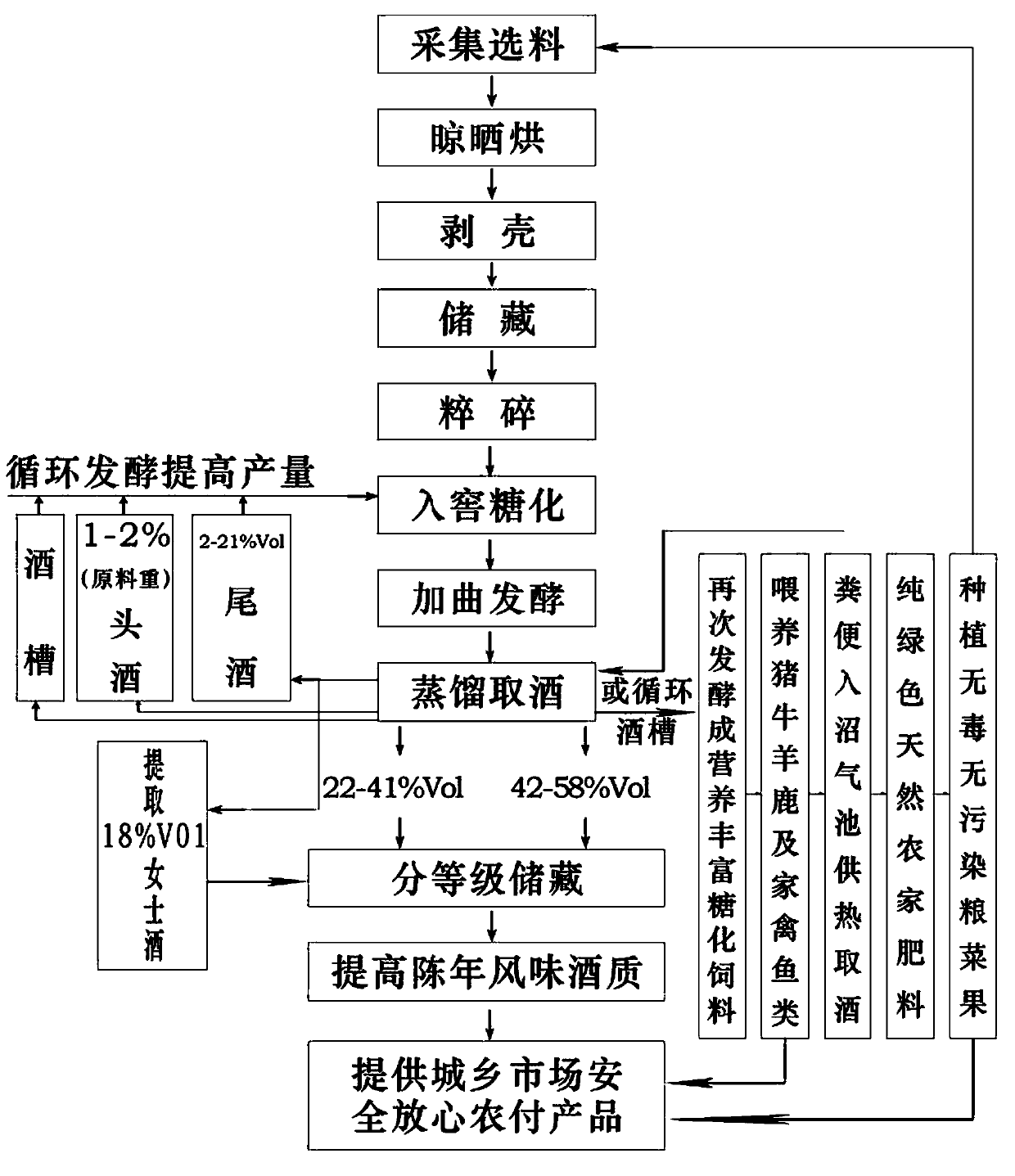Method for brewing wine by using wild fruits in mountain forest
A technology of wild fruits and forests, applied in the field of winemaking, to achieve the effects of simple process, elimination of pollution, and saving of fermentation cycle
- Summary
- Abstract
- Description
- Claims
- Application Information
AI Technical Summary
Problems solved by technology
Method used
Image
Examples
Embodiment 1
[0057] The present embodiment adopts three kinds of mountain wild fruits of acorn, plantain, and ginkgo to make wine, comprising the following steps:
[0058] 1) Raw material preparation: The main raw materials are collected, stored, sorted, and the defective products are crushed into 40-mesh particles; the water content is about 15%, and acorns, plantains, and ginkgo are mixed into 50kg at a ratio of 1:1:1.
[0059] 2) Fermentation: add 150kg of water, mix it with raw materials, put it in a ceramic fermenter, add active dry yeast powder with a weight ratio of 0.7% of raw materials, mix evenly, cover with non-toxic super-grade kraft paper, and place it at a temperature of 25-28 ℃ fermentation, stirring evenly once a day.
[0060] 3) End of fermentation: After 9 days, there is no floating substance on the surface, the raw material sinks to the bottom of the cellar, the material liquid is in a static state, without bubbles, the liquid changes from turbid to clear brown or beer c...
Embodiment 2
[0066] Present embodiment adopts ginkgo to make wine, comprises the following steps:
[0067] 1) Raw material preparation: The main raw materials are collected, stored, sorted and defective products are crushed into 40-mesh particles; the water content is about 15%, 50kg.
[0068] 2) Fermentation: add 150kg of water, mix with the raw materials, place in a glass fermenter, add active dry yeast powder with a weight ratio of 0.7% of the raw materials, mix evenly, cover with non-toxic super-grade kraft paper, and place at a temperature of 28- Ferment at 30°C and stir evenly once a day.
[0069] 3) End of fermentation: After 8 days, there is no floating substance on the surface, the raw material sinks to the bottom of the cellar, the material liquid is in a static state, without bubbles, the liquid changes from turbid to clear brown or beer color, and the liquid surface is covered by mold spores, the fermentation is over When the pH value was 4.6, the fermentation ended.
[0070]...
Embodiment 3
[0075] Present embodiment adopts acorn and ginkgo two kinds of mountain forest wild fruits to make wine, comprising the following steps:
[0076] 1) Raw material preparation: The main raw materials are collected, stored, sorted, and the defective products are crushed into 40-mesh particles; the water content is about 15%, and acorns and ginkgo are mixed into 50kg at a ratio of 2:1.
[0077] 2) Fermentation: add 150kg of water, mix with raw materials, place in a 304 stainless steel fermenter, add active dry yeast powder with a weight ratio of 0.7%, mix evenly, cover with non-toxic super-grade kraft paper, and place at a temperature of 30- Ferment at 32°C and stir evenly once a day.
[0078] 3) End of fermentation: After 7 days, there is no floating substance on the surface, the raw material sinks to the bottom of the cellar, the material liquid is in a static state, without bubbles, the liquid changes from turbid to clear brown or beer color, and the liquid surface is covered b...
PUM
| Property | Measurement | Unit |
|---|---|---|
| boiling point | aaaaa | aaaaa |
Abstract
Description
Claims
Application Information
 Login to View More
Login to View More - R&D
- Intellectual Property
- Life Sciences
- Materials
- Tech Scout
- Unparalleled Data Quality
- Higher Quality Content
- 60% Fewer Hallucinations
Browse by: Latest US Patents, China's latest patents, Technical Efficacy Thesaurus, Application Domain, Technology Topic, Popular Technical Reports.
© 2025 PatSnap. All rights reserved.Legal|Privacy policy|Modern Slavery Act Transparency Statement|Sitemap|About US| Contact US: help@patsnap.com

